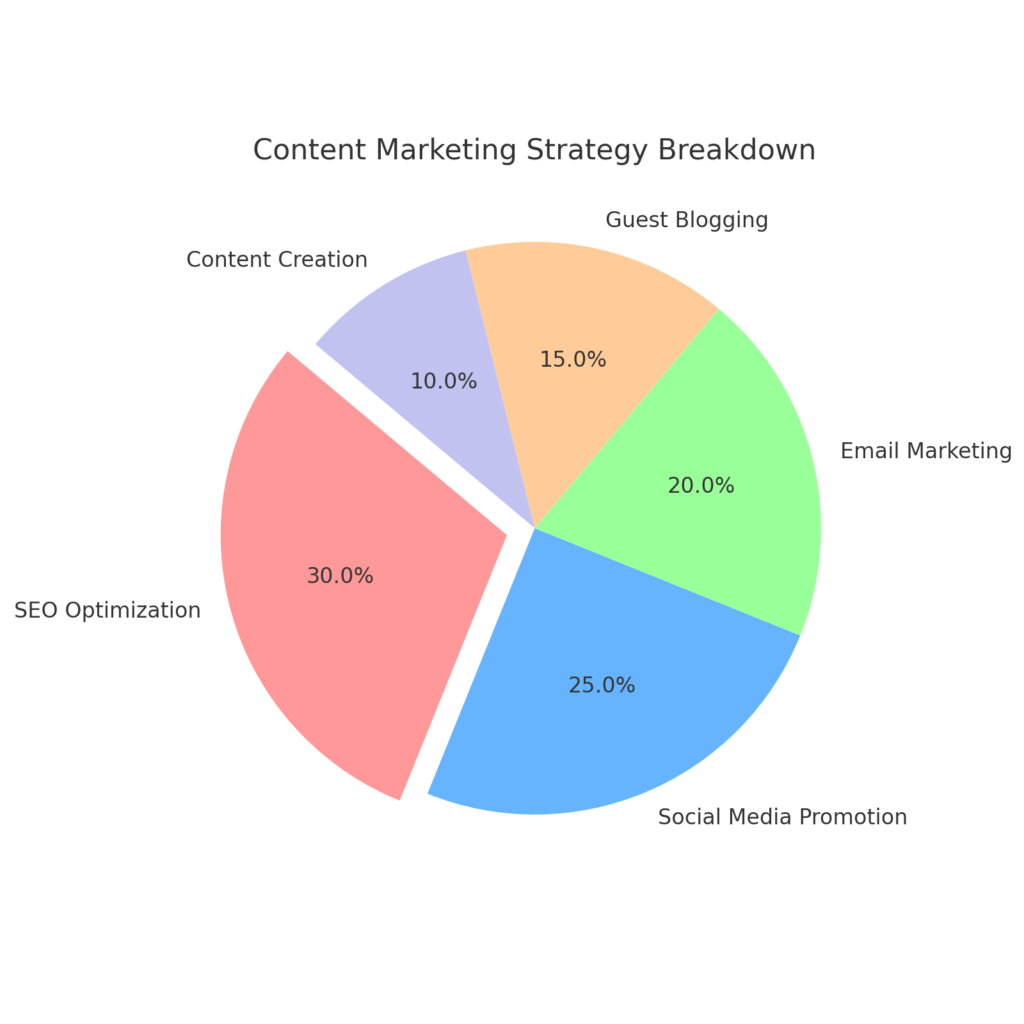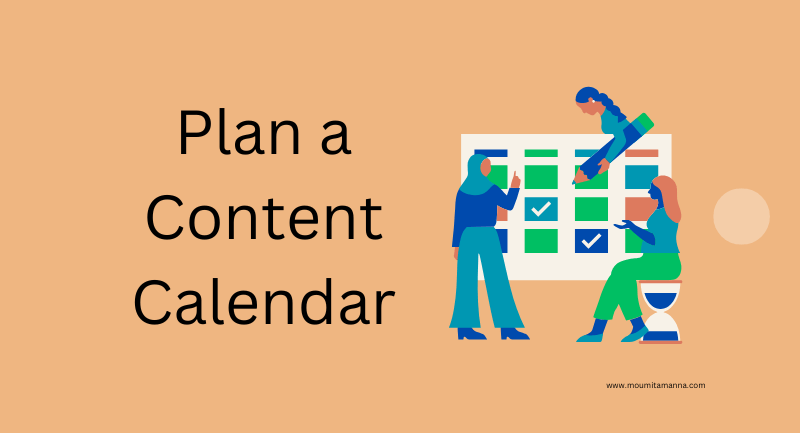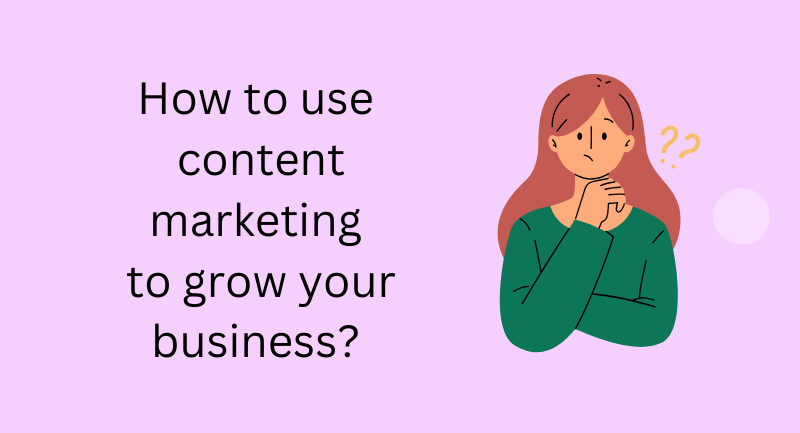Think that with all your heart and soul You have created a very good product and service, but no one knows it exists or how much it could help them solve their problems or make their lives easier. Frustrating, right? That’s where content marketing comes in as your superhero.
Content marketing isn’t just about blogging, it’s about writing strategic, valuable, and engaging content that pulls people toward your business.
In today’s digital world, your audience is constantly craving solutions, scrolling, and searching. The businesses that win? They’re the ones showing up with content that says, “Hey, we’ve got exactly what you need!”
Table of Contents
So, why does content marketing matter so much? It’s simple, it drives traffic, builds trust, and turns curious visitors into loyal customers. If you’re wondering how to make this magic happen for your business, stick around. In this guide, I’ll walk you through practical, actionable steps to use content marketing to grow your business. Let’s get started!
You can also get your free content writer for your website.
If you haven’t started yet and are thinking of starting your business site, read this expert’s guide before starting your blog journey.
Don’t have time to make a content strategy and write your own content? Hire an expert SEO content writer to get your work done more effectively.
Why Content Marketing is Essential for Business Growth
Did you know that 70% of marketers are actively investing in content marketing, and businesses with blogs generate 67% more leads than those without? Oh, and here’s a kicker: content marketing costs 62% less than traditional marketing but delivers 3x as many leads. Mind-blowing, right?
Are you tired of handling all the job done by yourself? then you can hire freelancer for your website. Research on internet to know the cost to hire a SEO content writer. Now, let’s dive into why content marketing is the not-so-secret sauce for growing your business:
1. It Boosts Brand Awareness
Think of content marketing as your main goal. Whether it’s a blog post, video, or a killer infographic, every piece of content you create puts your brand in front of potential customers. Over time, people start to recognize you—and we all know, familiarity breeds trust (and sales!).
2. It Drives Organic Traffic
If someone searches for a solution to their problem, your blog post or how-to video pops up at the top of Google. That’s the power of SEO-driven content marketing. Organic traffic isn’t only free; it’s also super valuable because these visitors are actively looking for what you offer.
3. It Builds Trust and Credibility
Everyone loves a helpful expert, but Nobody likes a pushy salesperson. By writing content that is informative, entertaining, or inspiring, you can create authority in your industry. And when people trust you, they’re more likely to buy from you.
4. It Supports Lead Generation and Conversions
Every blog post, free guide, or email newsletter you create is a stepping stone to converting casual readers into paying customers. Content acts like breadcrumbs that lead your audience straight to your sales funnel—and the best part? It works 24/7.
Content marketing isn’t just a marketing strategy; it’s a growth strategy. Whether you’re a one-person startup or a well-established business, great content has the power to amplify your voice, attract the right audience, and turn potential customers into loyal fans. So, ready to unlock the magic? Let’s keep going!
Steps to Use Content Marketing to Grow Your Business
Content marketing may seem overwhelming at first, but once you break it down into clear steps, it’s like following a recipe for success. Let’s take this journey one step at a time—ready? Here we go!
If you are testing a lots of time on creating a post, then learn “How to Write a content quickly” to make it fast.
Step 1: Understand Your Target Audience
You wouldn’t bake a cake without knowing if your guests prefer chocolate or vanilla, right? The same goes for your content. Start by getting to know your audience like you’re best friends:

Create Customer Personas
Let’s play a little game of imagination, shall we? Picture your ideal customers as real people. What are they like? How old are they? What do they do for a living? Maybe one of them is Sophia, a 35-year-old working mom juggling her career in marketing with soccer practice drop-offs and PTA meetings. Her hobbies? I like listening to true crime podcasts and occasionally sneaking in a Netflix binge when the kids are asleep. What keeps her up at night? She is probably trying to figure out how to meet deadlines without missing her daughter’s school play.
Or maybe there’s Ryan, a 28-year-old startup founder who lives off cold brew and thrives on chaos. His hobbies include geeking out over the latest tech and dreaming up ways to outsmart his competitors. His biggest worry? Scaling his business without burning out.
The more vividly you can imagine your audience, the easier it becomes to create content that speaks directly to them. Give them names, think about their daily lives, and imagine their joys, frustrations, and everything in between. The goal here is simple: make your audience feel like you get them.
Identify Their Pain Points and Needs
Now that we’ve got Sophia and Ryan figured out, let’s dive deeper into their world. What challenges are they facing? What’s the one thing they wish they had that could make their lives easier or better?
For Sophia, maybe her biggest pain point is finding time to upskill in her career without neglecting her family. Your content could offer her bite-sized learning tips or productivity hacks tailored for busy professionals.
Ryan, on the other hand, might be struggling with marketing his startup on a shoestring budget. A blog post titled “10 Low-Cost Marketing Hacks for Startups” could be the exact thing he’s Googling at midnight.
Here’s the secret: when you identify their pain points, you’re uncovering what they’re actively searching for. This is called search intent, the most important factor of SEO. And when your content shows up as the solution, you’re not just offering help—you’re earning their trust.
The takeaway? Your content isn’t about selling; it’s about solving. It’s about being the friend, mentor, or guide your audience didn’t know they needed. So go ahead, step into their shoes, and start creating content that feels tailor-made for them. You’ll be surprised how far a little empathy and understanding can take you!
Step 2: Set Clear Goals

Alright, before you get carried away creating awesome content, let’s hit the pause button for a second and ask yourself: What exactly do I want my content to achieve?
Here’s the thing: If you don’t have clear goals, it’s like setting out on a road trip without a map. You’ll probably have a great time, but you’ll end up going in circles and wondering where the heck you’re headed. Setting specific, measurable, and time-bound goals gives your content marketing purpose—and it helps you stay on track.
The Power of SMART Goals
You’ve probably heard of SMART goals. They’re like the superhero formula for goal-setting. Let’s break them down:
- Specific: Don’t be vague! Instead of “I want more traffic,” go with something like “I want to increase my website traffic by 20%.”
- Measurable: You need a way to track progress. If your goal is traffic, you can measure it with tools like Google Analytics.
- Achievable: Set goals that stretch you, but don’t set yourself up for failure. Aiming for 1000 leads in a week might be a bit much if you’re just getting started.
- Relevant: Make sure your goals align with your business objectives. If you’re trying to boost sales, focus on content that drives conversions.
- Time-bound: Give your goals a deadline. Want to boost your leads? Maybe target a 30-day window or 3 months.
Examples to Get You Inspired
Here are a few ideas for setting your own SMART goals:
- Boost website traffic: “I want to increase my site’s traffic by 20% in the next 3 months.”
- Generate leads: “I want to generate 50 leads per week through blog posts and email sign-ups.”
- Increase sales: “I want to double my product sales by the end of this quarter with content that drives conversions.”
Write It Down, Then Make It Happen
The key here? Writing it down. Research shows that people who write down their goals are 42% more likely to achieve them. So, grab a notebook, a whiteboard, or even a note on your phone and get those goals down. Don’t just think about them—write them down, make them real!
By setting clear, specific goals, you’ll have a roadmap to follow, and every piece of content you create will be driving you closer to your target. It’s all about staying focused, tracking your progress, and celebrating those wins when you hit your milestones!
Ready to crush your goals? Let’s do this!
Step 3: Develop a Content Strategy

Think of your content strategy like a game plan for your business’s success—it’s the playbook that’ll guide you to victory! Without it, you’re just winging it, and we all know how that goes. Imagine trying to build a house without a blueprint—chaos, right? The same goes for content marketing. You need a solid strategy to ensure every piece of content serves a purpose and takes you closer to your business goals.

Here’s how to break it down and create a strategy that keeps you on point:
Choose Your Content Types:
Blogs, videos, podcasts, infographics—pick what works best for your audience. For example, if your target audience loves quick tips, short videos might be the way to go. Or if they’re researching complex topics, long-form blog posts will work wonders. Mixing it up keeps things interesting and engages people in different ways!
Pick Your Platforms:
Not all social media platforms are created equal. Think about where your audience hangs out. Are they scrolling through Instagram, scrolling LinkedIn for professional insights, or watching YouTube tutorials? Choose the platforms where you can reach your audience effectively. For example, a fitness brand might thrive on Instagram with daily workout tips, while a B2B SaaS company may see better results on LinkedIn with thought leadership content. Also learn to write a perfect blog for company websites.
Create a Content Calendar:
No more scrambling for last-minute content ideas! A content calendar is your best friend. It helps you stay organized and consistent. Plan with topics, publish dates, and who’s in charge of creating each piece. Plus, it lets you balance your content mix—blogs, social media posts, and videos—so you’re not focusing too much on one type.
Align with Business Goals:
Your content should always tie back to your business goals. Whether you’re aiming to increase brand awareness, generate leads, or boost sales, every piece of content should help you get closer to achieving those objectives. For instance, if your goal is to increase leads, create content that nurtures your audience—like downloadable guides or webinars that encourage people to sign up.
A solid content strategy isn’t just about creating content—it’s about creating content that works. Stay organized, plan, and always keep your audience and goals in mind. With the right strategy, you’ll not only keep your content game strong but also drive real business results.
Choose Your Content Types
This is where you get to have a little fun! There’s no one-size-fits-all when it comes to content, so mix it up to keep things fresh and exciting.
When it comes to content, variety is the spice of life! Here’s a deeper look at some content types you should consider including in your strategy, each with its superpower to help you reach your audience in different ways:
Blogs: for more organic traffic over time
Blogs are the backbone of content marketing. They’re perfect for explaining a topic, showcasing your expertise, and answering common questions. Blogging regularly not only builds your authority in your niche but also boosts your SEO by giving you plenty of opportunities to use keywords and create valuable backlinks. Plus, with well-optimized blog posts, your content becomes discoverable on search engines, bringing in more organic traffic over time.
Videos: showcase your brand’s personality
Videos are the ultimate tool for creating a personal connection with your audience. Whether it’s a behind-the-scenes look at your company, a step-by-step product tutorial, or even a fun explainer video, videos offer a great way to showcase your brand’s personality. Bonus: YouTube is the second largest search engine in the world, making video content an SEO goldmine when optimized with the right keywords.
Infographics: Increase Website Traffic
Ever tried to explain something complicated and wished you could just show it? Infographics make complex information easy to digest and share. By combining visuals with data, you can break down big concepts into bite-sized, shareable chunks. People love visuals, and infographics are known for increasing engagement, making them an excellent tool for social media sharing and blog traffic.
eBooks to Attract Serious Leads
If you’re looking to attract serious leads, eBooks are a must. These longer-form pieces of content allow you to explore a topic in-depth, providing valuable insights and actionable takeaways. Since they require a bit more effort to create, eBooks also signal a higher level of commitment from your audience. You can use them to capture email addresses in exchange for downloads—perfect for building your lead list and nurturing relationships.
By mixing up these content types, you’ll be able to engage your audience at different touchpoints, keeping your strategy fresh and SEO-friendly.
The more variety you have, the more ways you’ll be able to connect with your audience. You don’t have to pick just one; mix and match to keep them engaged!
Pick the platforms where you will share your blog posts

Now, let’s talk about where your content will live. Sure, you can create amazing blog posts, but if no one sees them, what’s the point? You need to go where your audience hangs out.
- Instagram: This platform is a visual paradise. It’s perfect for sharing quick tips, lifestyle content, or behind-the-scenes moments. Use eye-catching visuals, reels, and carousel posts to grab attention. Have a fitness brand? Share workout snippets or motivational quotes. Run a bakery? Showcase those mouthwatering cupcakes and pastries! Pro tip: Consistent use of hashtags and trendy audio boosts visibility.
- LinkedIn: Think of LinkedIn as a coffee shop for professionals. It’s ideal for sharing industry insights, B2B content, or positioning yourself as a thought leader. For example, if you’re a digital marketer, you can post about SEO trends or success stories with your clients. Add value, spark conversations, and watch your network grow! Learn how to write content that can create maximum conversion rate, for your client’s site.
- YouTube: Got how-to guides or engaging stories to tell? YouTube is your go-to. It’s the second-largest search engine, meaning a well-optimized video can bring in serious traffic. Whether it’s tech tutorials, makeup looks, or travel vlogs, the platform thrives on engaging visuals. Don’t forget to optimize video titles, descriptions, and tags for better discoverability!
- Twitter: Twitter is like the news ticker for the digital age. It’s fantastic for sharing quick, punchy updates, trending hashtags, or joining conversations around hot topics. For example, tech companies can share product updates or commentary on industry trends. Want to create a buzz? Start a Twitter thread or participate in a trending hashtag. Just keep it short and impactful!
- Facebook: While not listed initially, it’s still worth considering. Facebook works great for community building through groups, running ads, and sharing content like videos or blog links. Think local businesses, niche communities, and personalized customer interactions.
Think about where your audience spends their time. If you’re targeting professionals, LinkedIn is your jam. But if you want to show off fun brand moments or behind-the-scenes action, Instagram or TikTok could be the way to go.
Plan a Content Calendar
Ah, the content calendar—your secret weapon for staying organized and avoiding the dreaded last-minute scramble. Without a calendar, you’ll be stuck creating random content whenever you feel like it, and that’s no way to build a solid strategy!

Here’s how to nail it:
- Map out topics: Think about what’s relevant to your audience and how you can help them.
- Set publish dates: Get those dates locked in! A content calendar keeps you accountable and ensures you’re posting consistently.
- Be flexible: Life happens, and trends change fast. Don’t be afraid to shuffle things around if you need to jump on a hot topic or update a post with new information.
By planning, you’ll save yourself a lot of stress and ensure that your content flows seamlessly across platforms. Plus, it lets you track your progress and adjust things when needed.
Your content strategy isn’t just a plan—it’s the blueprint that will help you reach your goals. Once you have a solid strategy in place, you’ll have a roadmap that leads you straight to business growth! Ready to create content that rocks? Let’s do it!
Step 4: Optimize for SEO
Here’s the truth: Great content is useless if nobody sees it. That’s where SEO comes in to work its magic.
- Do some keyword research to find out what your audience is searching for.
- Use on-page SEO tips like catchy headings, meta descriptions, and internal links to make your content Google-friendly.
- Focus on evergreen content—the kind that stays relevant long after it’s published.
Step 5: Create High-Quality Content
Now comes the fun part: creating content that wows your audience!
- Focus on value and originality. Give your readers something they can’t find anywhere else.
- Use storytelling. People connect with stories, not sales pitches. Weave a narrative that pulls them in and keeps them hooked.
- Be consistent with your brand voice. Whether it’s playful, professional, or quirky, stick to a tone that reflects your brand.
Step 6: Promote Your Content
Alright, you’ve put in the hard work creating stellar content, and now it’s time to let the world see it! Think of this step as throwing the best party in town—but you need to send out the invites before people can show up and enjoy it. So, let’s dive into how you can promote your content and get the attention it truly deserves!
1. Share It on Social Media
Social media is your loudspeaker, your megaphone, your “Hey, look at this!” sign! It’s the easiest (and fastest) way to get your content in front of an audience.
- Make it pop: Don’t just drop a link and walk away. Craft eye-catching captions that spark curiosity or offer value.
- Use visuals: People scroll quickly, so make sure you have images, videos, or infographics that stop them mid-scroll. The goal is to get them to pause, click, and engage.
- Hashtags, baby: Use relevant hashtags to boost discoverability. But don’t go overboard—focus on a few targeted ones that’ll bring the right crowd.
Whether it’s Facebook, Instagram, Twitter, or TikTok—choose the platforms where your audience is most active and get your content in front of them with style.
2. Collaborate with Influencers and Industry Leaders
Ever heard the phrase, “It’s not what you know, it’s who you know”? Well, when it comes to promoting content, this is 100% true! Collaborating with influencers or industry leaders can give your content an instant credibility boost and widen your reach dramatically.
- Why it works: A shoutout from someone with a big following can put your content in front of people who may never have discovered you otherwise.
- How to approach it: Reach out to influencers or thought leaders in your niche with a friendly message. Offer value—maybe you feature them in your content or they get access to exclusive insights in exchange for sharing it with their audience.
It’s all about building relationships and leveraging their influence to help boost your visibility.
3. Use Email Marketing
Don’t underestimate the power of a well-timed email! If you’ve got a solid email list, promoting your content via email can drive serious traffic.
- Craft a catchy subject line: Your email subject is the first thing people see, so make it tempting enough to get them to open it. Think curiosity, value, or urgency.
- Keep it simple: A brief, clear message with a direct link to your content can work wonders. Sometimes, all it takes is a quick “Hey, check this out!” to drive clicks.
- Segment your list: Personalize your emails to specific segments of your audience. That way, you’re sending the right content to the right people.
Email marketing isn’t dead—it’s still one of the most effective ways to drive traffic, especially when you’ve got a strong list of engaged subscribers.
Promoting your content is all about getting the word out in a way that feels natural and authentic. So, use social media, leverage your network, and tap into the power of email to spread the love and grow your reach. Ready to get your content noticed? Let’s go!
Step 7: Analyze and Improve
Now that your content is out there making waves, it’s time to measure the splash! Think of your content marketing like an ongoing experiment—because the more you test and track, the better you’ll get at creating content that truly works. Ready to dig into the numbers and keep improving? Let’s do it!
1. Track Performance with Analytics Tools
This is where the magic happens! Tools like Google Analytics are your best friends when it comes to understanding how well your content is performing. But don’t get overwhelmed by all the data—focus on the key metrics that matter.
- Page Views: This shows how many people are landing on your content. More views = more people are finding your stuff.
- Time on Site: Are people sticking around and reading your posts, or are they bouncing off quickly? If they’re engaged, they’re probably loving your content.
- Conversions: This is where the real magic happens. How many visitors are turning into leads, subscribers, or customers? If your content is doing its job, this number should be climbing!
These metrics are your roadmap to success, helping you understand what’s working and where to double down your efforts.
2. Identify High-Performing Content
When you see something working, why stop there? If a particular blog post, video, or infographic is getting a ton of views and engagement, take note!
- Do more of what works: If your “Top 10 Tips” article is going viral, you might want to create a part 2 or write similar content on the same topic.
- Repurpose your hits: Turn a high-performing blog post into a video, infographic, or even a podcast episode to reach new audiences.
Your audience is telling you what they love through their clicks, so listen up and give them more of what they’re craving!
3. Update Older Content
Old content doesn’t have to be forgotten content! Your top posts might just need a little TLC to stay relevant.
- Freshen it up: Revisit older blog posts or articles and add new stats, case studies, or insights to make them feel fresh again.
- SEO updates: Refresh your keyword strategy and optimize old posts to keep them ranking. Google loves fresh, relevant content, so this can give your content a second life and boost its visibility!
By regularly updating your content, you’re ensuring it stays valuable and continues to perform well over time.
Content marketing isn’t a “set it and forget it” kind of thing—it’s all about testing, learning, and tweaking to make sure you’re always improving. So, track your performance, identify what’s working, and keep optimizing. Every experiment helps you get closer to that perfect content recipe! Ready to improve and level up? Let’s get started!
Content marketing isn’t a one-and-done task—it’s a journey. But with these steps, you’ll have a clear roadmap to follow, and before you know it, you’ll be reaping the rewards. Ready to start growing your business one amazing piece of content at a time? Let’s do this!
Examples of Successful Content Marketing
Let’s take a look at a couple of businesses that nailed content marketing and saw some serious growth:
- HubSpot: HubSpot is the content marketing king. They built an empire by offering free, helpful resources—think blogs, eBooks, and templates. Their strategy? Provide so much value that people trust them enough to turn to their paid services.
- Airbnb: Airbnb’s content isn’t just about booking stays; it’s about experiences. They showcase stunning travel stories, and their “Experiences” feature creates authentic content that attracts travelers and hosts alike. Their strategy? Inspire action through compelling storytelling.
What made these strategies effective? They focused on offering value before asking for anything in return, built trust with their audience, and were consistent in their efforts. It’s all about engagement over promotion!
Common Mistakes to Avoid
Let’s be real: We’ve all made mistakes. In content marketing, a few blunders can seriously hurt your efforts. Here are some common ones to avoid:
Producing irrelevant or low-quality content:
No one has time for content that does not provide the exact information that you are searching for. If you are reading a blog, expecting some valuable information, and instead, you get different stiffs. That’s exactly why your content needs to add value and solve a problem. If it’s just a blog without proper information or value, it’s taking up space on the internet.
As an example, If you were a reader, would you keep coming back to a blog that didn’t help you? Of course not! So, make your content worth their time.
Whether it’s sharing thoughts, answering questions, or providing hacks, make sure your audience leaves feeling like they read something useful. Focus on writing high-quality content, over quantity, every single time!
Ignoring SEO:
Imagine throwing the best party ever, but you forget to send out invitations. That’s what happens when you ignore SEO. Your content might be amazing, but without SEO, it’s just sitting there in the dark, unnoticed.
SEO is like the spotlight that guides people to your content. By including proper keyword and optimizing your posts, you’re making sure search engines can find you and show your content to the right people. It’s like having a personal assistant working 24/7 to bring in new readers! So, take the time to optimize and watch search engines help your content reach the masses!
Inconsistency in publishing:
Posting once every few months? That’s like throwing an epic party but forgetting to invite anyone! Your audience won’t stick around if they don’t know when to expect your next post. Consistency is the magic sauce that keeps people coming back for more.
When you publish regularly, your audience knows exactly where to find you, and they’ll start anticipating your content like a favorite TV show. So, don’t keep them waiting! Keep the momentum going, and you’ll build a loyal audience that’s always ready for your next post.
Not analyzing performance:
Not checking how your content is performing? That’s like driving without a map—you’re just guessing where you’re going!
Analytics are your GPS for content success. They show you what’s working, what’s not, and where to go next. Are your blog posts getting tons of traffic but your videos are struggling? Time to adjust your strategy! Use those insights to make tweaks and improve your content over time. The more you analyze, the sharper your content game gets!
Simple, right? Keep these tips in mind, and you’ll avoid common pitfalls and make your content marketing a lot more effective!
Tools and Resources for Effective Content Marketing
Creating and promoting amazing content is easier with the right tools. Here’s a list to help you get started:
- Content creation tools:
- Canva for beautiful visuals (no design degree needed).
- Grammarly for perfect grammar and smooth writing.
- BuzzSumo for discovering trending topics and ideas.
- Content distribution tools:
- Hootsuite for social media scheduling—get organized and save time!
- Mailchimp for email campaigns that get opened.
- Analytics tools:
- Google Analytics to track website traffic and user behavior.
- SEMrush to dig deep into SEO performance and competitor analysis.
These tools will make your content marketing run like a well-oiled machine!
Conclusion
And there you have it—your ultimate guide to using content marketing to grow your business! Content marketing isn’t just about creating content; it’s about building real connections, providing value, and keeping your audience coming back for more. Whether you’re just starting or refining your strategy, the key is to stay consistent, keep improving, and always be in tune with what your audience needs.
So, are you ready to roll up your sleeves and create some impactful content? Remember, it doesn’t have to be perfect from day one. Just start, experiment, and learn along the way!
Ready to grow your business? Start creating content that speaks to your audience today! Let’s do this!
FAQs Section
Do you have some questions? Let’s clear them up:.
